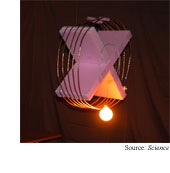|
NEWS
|
Heat sounds power
Thermoacoustic electricity generators -- devices
that turn heat to sound waves, then turn sound waves to
electricity -- are closer to practical application thanks
to five related developments that optimize and miniaturize
the generators. Practical thermoacoustic electricity generators
will generate power from any source of heat, including
power plant and computer chip waste heat, and sunlight.
(Miniature
Acoustic Prime Mover Operating at 10 KHz, Pressurization
of High-frequency Acoustic Heat Engines for Power Applications,
Acoustic
Conversion of Heat to Sound at Mid-Audio Frequencies,
Synchronization
of Small Thermoacoustic Oscillators, Performance
of Annular High-frequency Acoustic Engines, 153rd
Meeting of the Acoustical Society of America, June 4–8,
2007)
Cutting the cord
 A experimental wireless power scheme uses magnetic
fields to transmit 60 watts of electricity between two
metal coils two meters apart with 40 percent efficiency.
The system could lead to wireless methods of powering
and charging portable electronic devices like cell phones
and laptop computers. (Wireless
Power Transfer via Strongly Coupled Magnetic Resonances,
Science, published online June 7, 2007)
A experimental wireless power scheme uses magnetic
fields to transmit 60 watts of electricity between two
metal coils two meters apart with 40 percent efficiency.
The system could lead to wireless methods of powering
and charging portable electronic devices like cell phones
and laptop computers. (Wireless
Power Transfer via Strongly Coupled Magnetic Resonances,
Science, published online June 7, 2007)
Spin logic
A proposed computer circuit uses the spin, or
orientation, of electrons to process the 1s and 0s of
computer logic more efficiently than today's chips. Computer
chips made from spin circuits would be faster and use
less power than today's chips and would also be reprogrammable.
(Spin-based
Logic in Semiconductors for Reconfigurable Large-scale
Circuits, Nature, May 31, 2007)
Plastic, heal thyself
A skin-like plastic that contains microscopic
channels can repeatedly heal itself. The channels contain
a liquid that reacts with a catalyst on the plastic's
surface to harden into more of the plastic. The material
could be used to make all manner of objects that automatically
and repeatedly repair nicks and scratches. (Self-Healing
Materials with Microvascular Networks, Nature Materials,
published online June 10, 2007)
Piggyback drug delivery
Bacteria that carry nanoparticles that pack genetic
material can penetrate mammalian cells to deliver the
genetic material to the cells' nuclei. The method of delivering
drugs is simpler and more versatile than using bacteria
alone and more effective than using nanoparticles alone.
(Bacteria-Mediated
Delivery of Nanoparticles and Cargo into Cells, Nature
Nanotechnology, published online June 10, 2007)
Double duty particles
A core-shell nanoparticle that scatters infrared
light at low intensities and absorbs it at high intensities
shows promise in illuminating and eliminating cancer cells.
The nanoparticles can be directed to tumor cells where
the scattering makes the cells highly visible in medical
images. The absorption ability allows physicians to heat
the cells to death. (Near-Infrared
Resonant Nanoshells for Combined Optical Imaging and Photothermal
Cancer Therapy, Nano Letters, published online
June 6, 2007) |
FEATURES
|
View
from the High Ground: ICL's John Pendry
Physics as machine tool, negative refractive
index, metamaterials, shattered wine glasses, higher capacity
DVDs, scientific backwaters, risk perception and practice,
practice, practice.
|
How
It Works: Quantum computing: qubits
Photons, electrons and atoms, oh my! These particles are
the raw materials for qubits, the basic building blocks
of quantum computers. |
|
 |
News RSS feed 
Blog RSS feed 
Bookshelf RSS feed

New: TRN's
Internet Services
TRN's Jobs Center
|
| |
|
| |
|
| |
"Physics
is to the rest of science what machine tools are
to engineering. A corollary is that science places
power in our hands which can be used for good or
ill. Technology has been abused in this way throughout
the ages from gunpowder to atomic bombs."
- John Pendry, Imperial College London |
|
| |
|
| |
Thanks
to Kevin from
GoldBamboo.com
for technical support |
|

